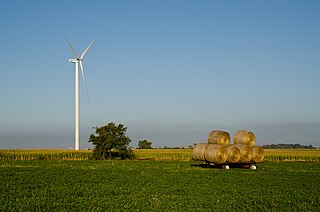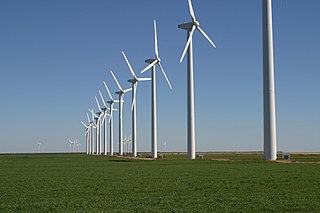
The London Array is a 175 turbine 630 MW Round 2 offshore wind farm located 20 km off the Kent coast in the outer Thames Estuary in the United Kingdom. It is the second largest offshore wind farm on Earth, after the Walney Extension.

Wind power in Australia is a mode of production of renewable electricity in Australia. Wind power is a rapidly expanding mode of renewable energy in Australia with an average annual rate of growth in installed capacity of 35% over the five years up to 2011. As of July 2018, there were 5,114 megawatts (MW) of installed capacity and a further 19,635 MW of capacity was proposed or committed. In 2017, wind power accounted for 5.7% of Australia's total electricity demand and 33.8% of total renewable energy supply. At the end of 2017 there were 85 wind farms in Australia, most of which had turbines from 1.5 to 3 MW. In addition, 14 projects with a combined installed capacity of 1,936 MW are either under construction or committed to be built in 2018 having reached financial closure.

The Altamont Pass wind farm is located in the Altamont Pass of the Diablo Range in Northern California. It is one of the earliest wind farms in the United States. The first wind turbines were placed on the Altamont in the early 1980s by Fayette Manufacturing Corporation on land owned by cattle rancher Joe Jess. The wind farm is composed of 4930 relatively small wind turbines of various types, making it at one time the largest wind farm in the world in terms of capacity. Altamont Pass is still one of the largest concentration of wind turbines in the world, with a capacity of 576 megawatts (MW), producing about 125 MW on average and 1.1 terawatt-hours (TWh) yearly. They were installed after the 1970s energy crisis in response to favorable tax policies for investors.
Acciona Energy, a subsidiary of Acciona based in Madrid, is a Spanish company developing renewable energy projects, including small hydro, biomass, solar energy and thermal energy, and the marketing of biofuels. It also has assets in the field of co-generation and wind turbine manufacture. As of 2007, it is carrying out research projects to produce hydrogen from wind power and to manufacture more efficient photovoltaic cells.

Wind power in Texas consists of many wind farms with a total installed nameplate capacity of 22,637 MW from over 40 different projects. Texas produces the most wind power of any U.S. state. According to ERCOT, wind power accounted for at least 15.7% of the electricity generated in Texas during 2017, as wind was 17.4% of electricity generated in ERCOT, which manages 90% of Texas's power.

Wind power has a long history in the state of California, with the initiative and early development occurring during Governor Jerry Brown's first two terms in the late 1970s and early 1980s. California's wind power capacity has grown by nearly 350% since 2001, when it was less than 1,700 MW. In 2016, wind energy now supplies about 6.9% of California's total electricity needs, or enough to power more than 1.3 million households. Most of California's wind generation is found in the Tehachapi area of Kern County, California, with some big projects in Solano, Contra Costa and Riverside counties as well. California is among the states with the largest amount of installed wind power capacity. In recent years, California has lagged behind other states when it comes to the installation of wind power. It was ranked 4th overall for wind power electrical generation at the end of 2016 behind Texas, Iowa, and Oklahoma. As of December 31, 2016, California had 5,662 megawatts (MW) of wind powered electricity generating capacity.

The American Wind Energy Association (AWEA) is a Washington, D.C.-based national trade association formed in 1974, representing wind power project developers, equipment suppliers, service providers, parts manufacturers, utilities, researchers, and others involved in the wind industry.

Clipper Windpower is a wind turbine manufacturing company founded in 2001 by James G.P. Dehlsen. It designed one of the largest wind turbines in the United States, manufactured in Cedar Rapids, Iowa. It was working collaboratively with the National Renewable Energy Laboratory.

The Titan Wind Project is 25MW wind farm which had a proposed expansion to 5,050 MW, formerly known as Rolling Thunder, based in South Dakota. The project developers, Clipper Windpower and BP Alternative Energy, expected to build Titan in several phases and, when completed, it would have been one of the largest wind farms in the world.

Wyoming has one of the highest wind power potentials of any state in the United States. As of 2016, Wyoming has 1489 megawatts (MW) of wind powered electricity generating capacity, responsible for 9.42% of in-state electricity production. Wyoming produced of 3,800 GWh in 2015, about 9% of the total.

Wind power in Montana is a growing industry. Montana had over 695 MW of wind generation capability by 2016, responsible for 7.6% of in-state electricity generation.

The US state of Colorado has vast wind energy resources and the installed capacity of wind power in Colorado has been growing significantly in recent years due federal incentives for wind power and the state's aggressive renewable portfolio standard that requires 30% of the state's electricity to come from renewable sources by 2020.
The Criterion Wind Project is a wind farm located on Backbone Mountain east of Oakland, Maryland, United States. The project has a rated capacity of 70 MW and uses 28 Liberty Wind Turbines manufactured by Clipper Windpower. Each of the wind turbines is about 415 feet tall. The Criterion Wind Project is owned by Criterion Power Partners, LLC, which is a subisiary of Exelon, and interconnected with the transmission system of the Potomac Edison Company. Electricity and renewable energy credits from the project are sold to the Old Dominion Electric Cooperative under a 20-year supply contract.

Spring Valley Wind Farm is Nevada's first wind farm. The farm is owned and operated by Pattern Energy. The facility is located in Spring Valley, northwest of Great Basin National Park and approximately 30 miles (48 km) east of Ely, Nevada. The 151.8 megawatts (203,600 hp) plant utilizes 66 2.3 megawatts (3,100 hp) wind turbines and occupies 77 acres (31 ha) in the center of Spring Valley, which consists of 7,673 acres (3,105 ha).

The Uppudaluwa Wind Farm is a 10.5 MW wind farm owned by PowerGen Lanka (Private) Limited in Uppudaluwa, Puttalam, Sri Lanka.

The Chokecherry and Sierra Madre Wind Energy Project is the largest proposed commercial wind generation facility in North America.

Shirley Wind is a wind farm in the Shirley section of Glenmore, Brown County, Wisconsin. The site, which opened in 2011, includes eight Nordex 2.5 wind turbines, each about 500 feet (150 m) tall. Originally developed by Emerging Energies LLC, it is owned by Duke Energy.

Wind power in Wisconsin contributes to the state's renewable portfolio standard established in 1998. There are several wind turbine installations and wind farms in the state, which as of 2016 had a generating capacity of 648 megawatts (MW). In 2016, wind power was responsible 2.4% of electricity produced in the state.


















